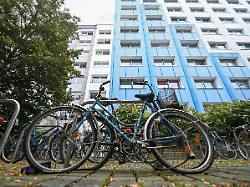Munich is the leader
Student housing rents are skyrocketing
09/21/2022, 12:22 p.m
Inflation and the rise in energy prices are also having an impact on the housing market. With a rent increase of up to 18.5 percent, the situation for students is getting worse. Even the most recent BAFÖG increase is not enough for most.
Students have to dig deeper into their pockets for their rent. On average, rents for student apartments are 5.9 percent higher than in the previous year Student housing report 2022 of the financial service provider MLP and the German Economic Institute. The rental prices have increased in all 38 university cities examined – in Berlin by as much as 18.5 percent.
In 2021, the average increase in these cities was 1.5 percent – the pandemic had slowed down price development. But the breather is over, according to the study makers. “Last year, rents in a number of cities even fell – this development has now fizzled out without a trace,” said MLP. Prices rose the least in Freiburg (3.1 percent), Frankfurt and Darmstadt (3.5 percent each). However, Freiburg had already made strong gains the year before with a rent increase of almost 6 percentage points.
Munich remains the most expensive place to study, where students have to shell out 787 euros for a 30-square-meter model apartment with normal furnishings near the university. Stuttgart has now caught up with Munich and is almost level with 786 euros. In Berlin, students pay 718 euros for the model apartment.
It is best in the east
It is comparatively cheap to live in the East: In Chemnitz, the model student shack costs 224 euros to rent, in Magdeburg 303 euros and in Leipzig 383 euros. These are amounts for warm rent. In addition to the pure rental costs, ancillary costs of 20 percent were calculated.
Living in shared flats has also become significantly more expensive: According to the study, students in Munich pay 545 euros for a 20 square meter room in a shared flat, 487 euros in Berlin and 473 euros in Stuttgart. A comparable room in Chemnitz costs 186 euros. The national average for such a model room has risen by 9.4 percent compared to the previous year.
Even the most recent BAföG increase cannot provide general financial relief, the MLP and the Institute of German Business said. The increased housing supplement of 360 euros in the BAFÖG maximum rate covers the rent for a student model apartment in only two university cities – namely in Chemnitz and Magdeburg. In Munich, students could pay just 17 square meters for the maximum surcharge.
Inflation weighs on students
“Due to the enormous increase in energy prices, demand is shifting towards smaller and cheaper apartments,” explained Michael Voigtländer, a real estate expert at the German Economic Institute. “In addition, many people who previously wanted to buy condominiums are now looking for rental apartments due to sharp rises in interest rates. As a result, competition in the market for student accommodation is intensifying – with corresponding consequences for rental costs and the supply.”
According to the study, inflation is also having a massive impact on students. Due to a lack of financial reserves and low income, students are more affected by the recent price increases than the average household. The median income of students has even deteriorated slightly recently (2020: 950 euros, 2018: 1000 euros). Many students are only just getting back on their feet financially after the Corona crisis and the loss of numerous student jobs, said MLP CEO Uwe Schroeder-Wildberg.
